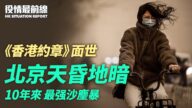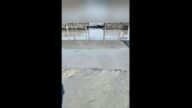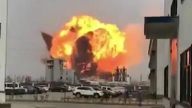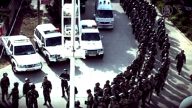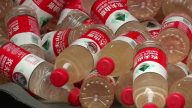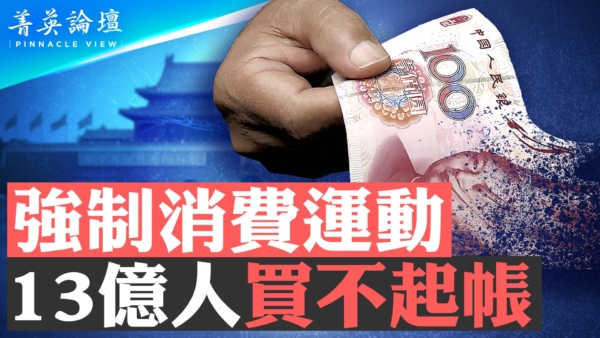【新唐人2014年02月11日訊】世界衛生組織(WHO)日前發佈的研究報告表明,中國的癌症在2012年的發病個案中,幾乎佔了全球一半,高居世界第一位。研究人士指出,癌症在中國所謂改革開放後大量出現,特別是以犧牲環境換來的「癌症村」已經高達200多個,而到目前為此,真正在潛心治理的卻是民間組織。
「淮河衛士」發起人霍岱珊,是河南周口市瀋丘縣人。2003年,霍岱珊註冊成立了「淮河水系生態環境科學研究中心」,他希望通過更多環保志願者的參與,來治理淮河污染。日前,《德國之聲》播出了霍岱珊的記錄片。
原為攝影記者的霍岱珊,1998年辭去公職後,通過公民調查方式,首次向公眾披露了大型企業「蓮花味精廠」、及淮河流域諸多的造紙企業污染水系,造成淮河岸邊出現數十個癌症村等相關內幕,隨後,霍岱珊受到中共當局的多次打壓和警告。
霍岱珊的兩個兒子也辭去大城市的工作,加入環保志願者「淮河衛士」的行列。霍敏浩是霍岱珊的小兒子,原來是廣東一家玩具工廠小有名氣的設計師。
霍敏浩:「我們成立的是民間環保組織,肯定不在體制內就沒有政府的資金給我們,我們跟基金會合作一些項目,那是在最近幾年才開始,在之前我們確實都是拿自己的積蓄來做環保,我們打點零工,做點小生意維持生活,大部分積蓄都拿來做環保。」
霍岱珊家裏擺放著一個很大的水族箱,養了幾十條從淮河水域帶回的畸形魚,這些「畸形魚」和標本,見證著淮河的污染。
「淮河衛士」環保志願者霍敏浩:「很久以前我們就發現河裡的這些魚骨胳畸形,發育的不完整,鱗片大大小小,有的缺對眼睛,大部分是脊柱彎曲和魚骨頭彎曲,所以我們就開始收集這些,活的我們有,死掉的我們冷凍起來了,現在有大半冰箱,還不是刻意收集的,漁民打到這種魚之後不好賣,有時候這條魚賣不掉,他就會打電話給我們。」
上世紀90年代初期,從部隊轉業的霍岱珊發現,沙潁河面上經常漂著成片的死魚。霍岱珊走訪了淮河兩岸的民眾後,發現所謂的「淮河治污工程」全是弄虛作假。
霍岱珊拍下孩子們為了抵禦臭氣的侵襲,戴著口罩上課,以及,大片死魚等照片,逐級反映,但多遭到嘲諷和白眼。而村中患癌的人數與日俱增。
霍敏浩:「長期飲用不安全、不健康的水,肯定會導致疾病的發生,這些在我們當地用現實驗證了這一點,就是很多的癌症村,淺層地下水受污染的村莊他們的癌症發病率非常高,每年都死幾十個人,主要表現在消化系統。 」
據不完全統計,截至去年春天,中國大陸「癌症村」超過200個,遍佈中國,涵蓋了27個省份。而世界衛生組織(WHO),在今年2月4號「世界癌症日」發表的《世界癌症報告》中說,2012年,全球癌症新病例有一半發生在亞洲,其中大部分發生在中國大陸。
據了解,廣東翁源縣上壩村3000多人,有250名死於各種癌症。而網絡熱傳的「中國癌症村地圖」,「癌症村」主要集中在中國的中東部,靠近城市的經濟發達地區,特別是水源污染地區。去年12月,中共國土資源部發佈消息,中國約有5000萬畝土地因污染嚴重無法耕種。
大陸「樂水行」項目發起人張峻峰,研究癌症多年。
大陸「樂水行」發起人張峻峰:「癌症這個問題,環境的物質變化,是一種誘因,而且這種誘因在最近的30年、40年左右,增長的速度是比較快的。最近的10到20年之內,農村的發病率非常高,工業污染、工廠造成水污染的情況之下,所帶來的各種不同的癌症也非常的多。」
張峻峰說,目前生物界和醫學界,對癌症的研究還具有侷限性,應該從更寬的視角,來認識癌症產生的原因和治癒措施。
採訪編輯/劉惠 後製/孫寧
Half of World’s New Cancer Cases occur in China.
World Health Organization (WHO) recently released a report,
revealing all new cancer cases in China,
account for half the cases around the world.
China has the highest number of new cancer cases in the world.
Researchers point out, there have been more cancer cases
in China since implementing the policy of
reform and opening up.
In particular there are more than 200 “cancer villages"
in China, which ensues from destroying
the once healthy environment.
However, currently only non-governmental organizations (NGO’s)
are dedicated to the treatment of local environments
of these cancer villages.
“Huai River Guardians" founder Huo Daishan is from Shenqiu
County of Zhoukou City, Henan Province.
In 2003, Huo Daishan established the “Ecological Environment
Science Research Centre for Water System of Huai River".
He aims to attract more environment protection volunteers’
involvement in treating the pollution in Huai River.
Recently, Deutsche Welle (DW) showed a documentary
about Huo Daishan’s story.
Huo Daishan was a photographer. In 1998 he resigned from
his position. Through citizen survey he managed
to disclose the situation to the public.
Large-scale enterprises such as “Lotus Flower Gourmet
Powder Factory”, and numerous paper-making
enterprises located in Huai River watershed,
have been allegedly responsible for polluting the water
system, hence producing a dozen or so cancer
villages along the Huai River.
After disclose of information, Huo Daishan has experienced
first hand warnings and much oppression.
Two sons of Huo Daishan also resigned from their jobs in big
cities, becoming environmental protection
volunteers as “Huai River Guardians".
Huo Minhao is theyoungest of his sons who was a famous designer
in a local toy plant of Guangdong Province.
Huo Minhao: “We established an NGO (non governmental
organization), which has no connection to any
level of government, thus receives no official funds.
We’ve cooperate only with certain foundations in some projects
during these recent years.
Prior to this, we actually took out our own savings to fund
all our activities.
Occasionally we worked or set up small businesses
helping us to support & fund the NGO. It took most
of our own savings to run it."
There is a large aquatic box in Huai River, which contains
many deformed fish whose condition was
created due to pollution.
Huo Minhao: “We’ve found some fish types in the river
having a cacoplastic ( deformed )skeleton with
dysplasia quite a long time ago.
Some have fish scales without uniform size, some are without
eyes, some have one or two eyes,
most of them have deformed spines and skeletons.
So we started to collect them. Some are still alive. But many
have died due to abnormalities, these fish
occupy most of the space in our fridge.
This is not from any type of intentional collection.
This is mainly from local fishermen who have caught
such fish, yet could not sell them and then rang us."
In the early 1990s, Huo Daishan had just ended his military
service and started a new civil job.
He frequently found many dead fish floating in Shaying River.
Huo Daishan visited the local people living in Huai River areas
and discovered, the so-called “Huai River Pollution
Treatment Project" was a total fake.
Huo Daishan took photos of children with masks on
in the classroom for resisting the bad odor due to
large amounts of dead fish.
He then appealed to different levels of the government,
but most of the time he received ironic and contemptuous looks.
On the other hand, the people suffering from cancer
in the villages dramatically increased.
Huo Minhao: “To drink dirty and unhealthy water
undoubtedly leads to diseases, which have been confirmed
by local realistic experiments.
In many cancer villages with polluted
shallow-layer underground water,
the cancer incidences rose very high
with several tens ofdeath cases,
mainly due to the cancers
related to the digestive system."
In terms of an incomplete statistic, until Spring of last year’s ,
there are more than 200 cancer villages in 27 provinces
across Mainland China.
According to the World Cancer Report published by WHO
in the World Cancer Day on Feb. 4, 2013,
half of new cancer cases in the world are from Asia,
and most of them are from Mainland China.
It is reported that among 3,000 people of Shangba Village of
Wengyuan County of Guangdong Province,
250 villagers have died from a variety of cancers.
The hotly hit “China’s Cancer Village Map" on the Internet,
illustrates cancer villages are mainly distributed
in the middle and eastern land of China,
closely connected to developed cities,
especially the regions with the most polluted water sources.
Last December, the Chinese Authorities’
Land Resource Ministry,
published news that around 5000 mu of land is impossible
to cultivate due to serious pollution.
Mainland “Walk, Water, Wonderful" project sponsor
Zhang Junfeng, researched cancers for many years.
Zhang Junfeng: “The actual physical change occurring in our
local environment, is one key factor to the causes of cancer.
Such a hugefactor & trigger, has experienced a fast
development during these past three to four
decades in China.
In the last ten or twenty years,
the cancer incidences in rural areas is very high.
Given the circumstances of industrial pollution
and water pollution,
a variety of cancer cases can be seen."
Zhang Junfeng says, Currently the biology field and
the medical field, all have limitations on cancer
study and research.
They are expected to realize the causes of cancers
and the corresponding curing measures
from a much wider perspective.
Interview & Edit/LiuHui Post-Production/SunNing



